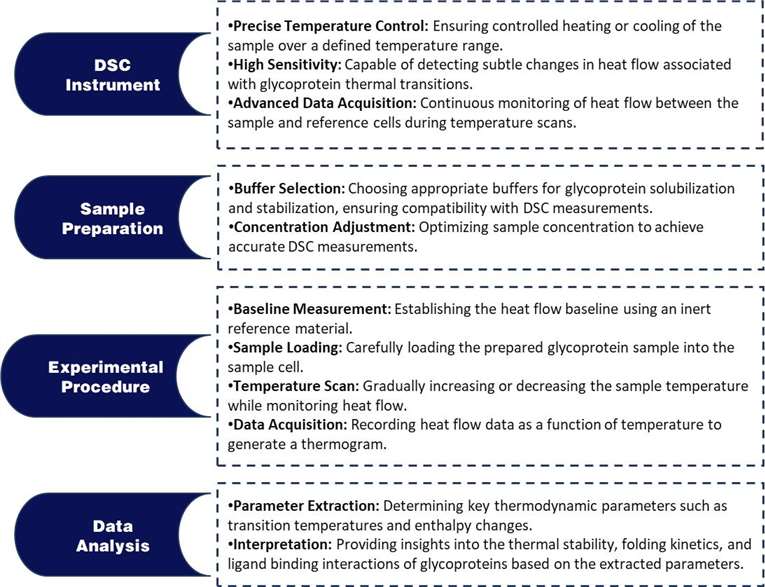Principle of Differential Scanning Calorimetry (DSC)
Differential Scanning Calorimetry (DSC) is a thermodynamic technique widely utilized for studying the thermal stability and conformational transitions of biomolecules, including proteins and glycoproteins. The fundamental principle of DSC is based on the measurement of heat flow associated with the differential response of a sample and reference material to controlled temperature changes. By subjecting the sample to a linear temperature ramp, the heat absorbed or released during endothermic or exothermic transitions is recorded, providing valuable insights into the thermal stability, folding/unfolding kinetics, and ligand binding interactions of biomolecules.
At Creative Proteomics, we offer comprehensive services utilizing DSC service to facilitate in-depth analysis of the thermal stability and conformational transitions of biomolecules, such as proteins and glycoproteins.
What Can We Provide:
Thermal Stability Assessment
- Customized Experimental Design:
Our team of experienced scientists collaborates closely with clients to develop customized experimental protocols tailored to their specific research objectives and sample requirements.
- Temperature Range Optimization:
We optimize the temperature range and ramp rate to ensure the accurate characterization of glycoprotein stability over relevant physiological or user-defined conditions.
- Data Analysis and Interpretation:
We provide comprehensive data analysis and interpretation services, including the determination of transition temperatures (Tm), enthalpy changes (ΔH), and heat capacity curves, to elucidate the thermal stability profiles of glycoproteins.
Ligand Binding Studies
- Binding Affinity Determination:
Our DSC-based approach enables the quantitative assessment of ligand binding interactions with glycoproteins, including small molecules, carbohydrates, and antibodies, facilitating the determination of binding affinities and thermodynamic parameters.
- Kinetic Analysis:
We offer kinetic analysis of binding interactions to elucidate the association and dissociation rates of ligands with glycoproteins, providing insights into the mechanism and dynamics of ligand binding.
Comparative Analysis
- Variant Comparison:
Our comparative DSC analysis allows for the comparison of thermal stability profiles among different glycoprotein variants, mutants, or glycosylation patterns, enabling the identification of structural features critical for stability and function.
- Environmental Impact Assessment:
We evaluate the impact of environmental factors such as pH, salt concentration, and solvent composition on glycoprotein stability, facilitating the optimization of formulation conditions and storage conditions.
Quality Assurance and Data Reporting
- Stringent Quality Control:
We adhere to strict quality control measures throughout the experimental workflow to ensure the reliability and reproducibility of results.
- Detailed Data Reporting:
We provide clients with comprehensive data reports containing detailed experimental protocols, raw data, and interpretive analysis, enabling them to make informed decisions and advance their research goals.
Advantages of Differential Scanning Calorimetry
- Quantitative Precision: DSC delivers precise measurements of thermodynamic parameters, including transition temperatures (Tm) and enthalpy changes (ΔH), enabling accurate assessment of glycoprotein stability and ligand binding affinity.
- Label-Free Analysis: Our DSC approach eliminates the need for exogenous labeling or modifications, ensuring the integrity of native glycoprotein structures and minimizing sample perturbation.
- Versatility: DSC can accommodate a wide range of glycoprotein samples, from purified proteins to complex mixtures, allowing for comprehensive analysis of diverse biological systems.
- Sensitivity: With its high sensitivity to protein conformational changes, DSC can detect subtle alterations induced by environmental factors, post-translational modifications, and ligand interactions.
- Real-Time Monitoring: Our DSC services enable real-time monitoring of thermal transitions in glycoproteins, providing dynamic insights into their folding-unfolding kinetics and response to external stimuli.
- Complementary Techniques: DSC data can be complemented with other biophysical techniques, such as circular dichroism (CD) and mass spectrometry (MS), for a more comprehensive understanding of glycoprotein structure and function.
- Scalability: Leveraging automation and high-throughput capabilities, we ensure efficient analysis of multiple glycoprotein samples, facilitating large-scale screening and optimization studies.
- Predictive Modeling: Thermodynamic parameters derived from DSC experiments can be used to develop predictive models of glycoprotein stability, guiding rational design strategies and drug discovery efforts.
 Workflow of Glycoprotein Differential Scanning Calorimetry Analysis
Workflow of Glycoprotein Differential Scanning Calorimetry Analysis
Sample Requirements for Glycoprotein Differential Scanning Calorimetry Analysis
| Sample Type | Sample Volume Required | Additional Information |
|---|---|---|
| Purified Glycoprotein | 100-500 µg | - Sample should be in a buffer compatible with fluorescence measurements. - Avoid buffers containing reducing agents or chaotropic agents. |
| Cell Culture Supernatant | 500 µL - 1 mL | - Supernatant should be clarified by centrifugation to remove debris. - Sample should be concentrated if necessary to achieve desired protein concentration. |
| Tissue Homogenate | Variable | - Homogenate should be prepared in a suitable buffer for glycoprotein solubilization. - Sample volume may vary depending on tissue type and protein concentration. |
| Serum/Plasma | 100-200 µL | - Sample should be collected using appropriate anticoagulants (e.g., EDTA) and stored at -80°C until analysis. - Avoid repeated freeze-thaw cycles. |
| Other Biological Fluids | Variable | - Sample volume and preparation method may vary depending on the specific fluid (e.g., urine, saliva, cerebrospinal fluid). - Consult with our experts for specific requirements. |




